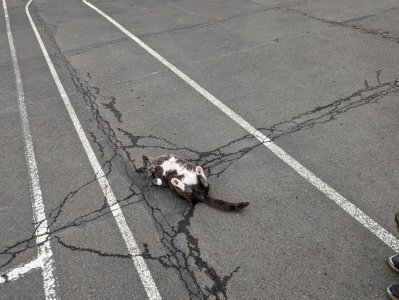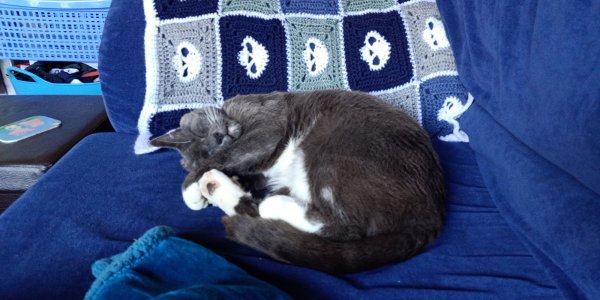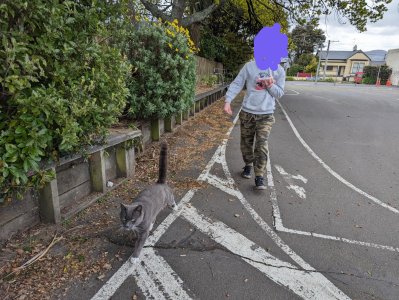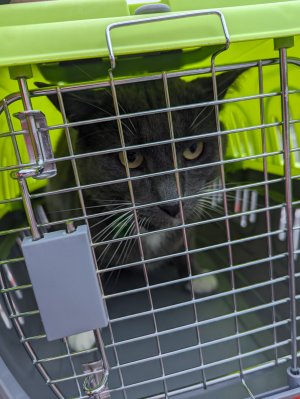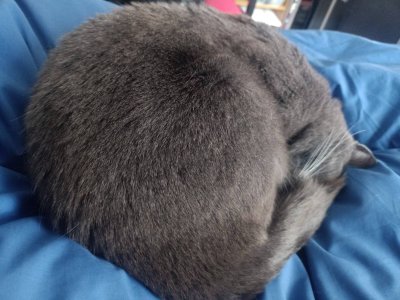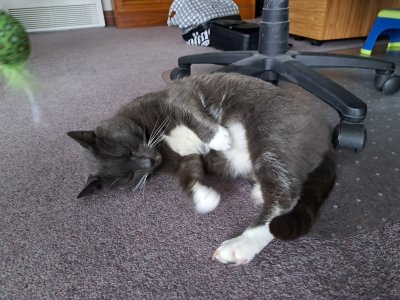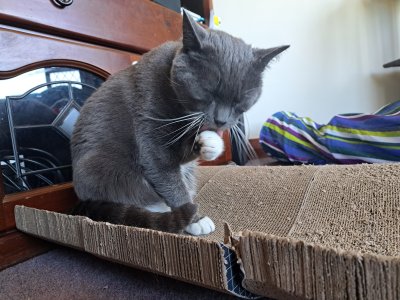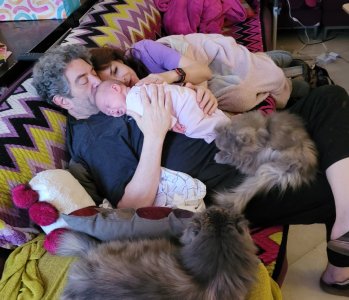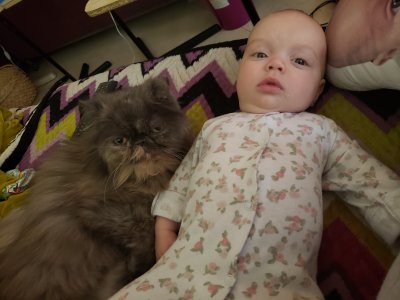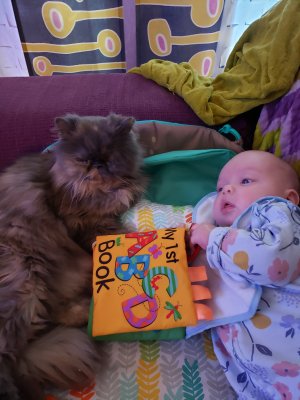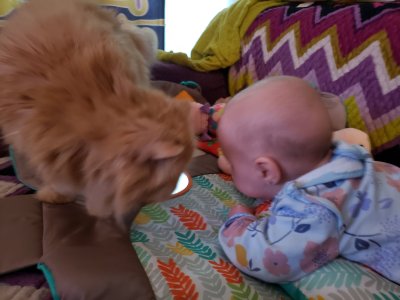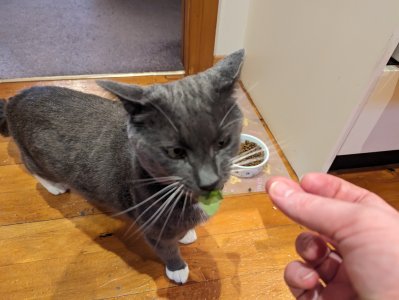The Lion in Your Lap
The Hidden Language of Cats
By Sarah Brown Dutton, 272 pages, $
28
The Cat’s Meow
By Jonathan B. Losos Viking, 400 pages, $28
BY RICHARD LEA
WHY DO WE love our cats so much? In “Jubilate: An Homage in Catterel Verse,” her tribute to the 18th-century poem “Jubilate Agno” by Christopher Smart, Joyce Carole Oates writes that a cat: . . . may come when called (like the Dg) but mostly she will not for (unlike the Dg) she has got an interior life, inscrutable, inaccessible, un-possessable. Perhaps there’s something about their disdainful independence, their languid indifference, that makes those moments when they deign to notice us all the sweeter. Poised, as Ms. Oates says, between “cuddling” and the “tribe of Tyger,” they represent a slice of the savanna in the living room, reconnecting us with the wilderness so many of us left behind.
But are our cats so very wild? According to the cat behaviorist Sarah Brown and the evolutionary biologist Jonathan Losos, house cats have been shaped by humanity for thousands of years. Ms. Brown begins “The Hidden Language of Cats: How They Have Us at Meow” by drawing a distinction between taming—where an individual animal “becomes biddable and often friendly”—and domestication, which “involves genetic change in a whole population over time.” She cites a 2007 survey showing that all domestic cats are descended from the African wildcat—the DNA is so similar that geneticists can’t tell the two apart. Subsequent studies have established that the gene pool of modern-day house cats comes from two regions: Egypt and the Fertile Crescent.
The story of the “tentative mutualistic relationship” between wildcats and Neolithic farmers, we are told, began some 4,000 to 6,000 years ago, when cats feasted on the rats that nibbled on the farmers’ stores of grain. Cats made it from the barn to the boudoir in Egypt around 1500 B.C., when their representations began appearing in temples and paintings of domestic settings. From there they took ship for the rest of the world. Unlike the dogs, cows and sheep that were domesticated by neolithic farmers, however, wildcats were—and remain—solitary animals. That solitary nature could have put their descendants at a disadvantage, but, according to Ms. Brown, house cats have “creatively learned” to live and work with humans.
Moreover, she argues, cats have “ingeniously” developed ways of tugging at our heart strings. The meow may be a defining trait of the house cat, but it is “almost exclusively reserved for cat-human interactions.” Meows can sound “friendly, demanding, sad, assertive, persuasive, persistent, plaintive, complaining, endearing, and even annoying,” but their fundamental frequencies (609 hertz, on average, compared to a wildcat’s calls at 255 hertz) are pitched at about the same level as the cry of a human baby—with “remarkably similar” acoustics. This raises the intriguing possibility, Ms. Brown suggests, that cats may have “hotwired our brains so we simply must respond to an urgent need to take care of them like a baby.” “The Hidden Language of Cats” is full of such striking facts. The author explains that cats have a dedicated set of receptors in their skin—similar to structures found in humans—that respond to slow, gentle stroking. We also learn that there is a window, stretching between two and seven weeks of age, during which kittens can become comfortable around people.
As a self-proclaimed cat lover, Ms. Brown is keen to smash certain stereotypes. She points to research showing that, contra Ms. Oates, house cats are far from “aloof and unreceptive,” as well as studies that demonstrate their “eagerness to listen, understand, and please.” And she is determined to celebrate the domestic cat’s achievements, judging everything about them as “impressive”—from their sense of smell to their purrs, tails and ears; their talent for reading our gaze; their ability to make their fur stand on end; and their modified meows.
Mr. Losos may be as much of a cat fanatic as Ms. Brown, and he covers much of the same material in his “The Cat’s Meow: How Cats Evolved From the Savanna to Your Sofa.” But, as a specialist in lizard biology, he is at one or two removes from the field, allowing him to examine the research with a little more distance and to situate it within a broader context.
Mr. Losos’s treatment of the sign identified by Ms. Brown as “tail up” is a case in point. Both authors introduce this flagpole signal—where cats point their tails straight in the air as they approach—with a sketch from their own experience. Ms. Brown recalls the first time she noted this behavior during her research, and Mr. Losos describes the greetings of his own cat. Both authors outline an elegant experiment that established, with the use of silhouettes, that an upright tail means—as Mr. Losos puts it—“I come in peace” or “glad to see you!” And both authors consider how the signal may have evolved. But while Ms. Brown observes that the only species in the cat family to use the tail-up sign are the domestic cat and the lion, Mr. Losos connects this behavior with the fact that lions and house cats live in social groups. According to Mr. Losos, this rare sociability explains “why the two species, and no other felines, exhibit the tail-up display.” He notes that large numbers of stray house cats will often organize themselves into colonies, then further subdivide into groups of related females to raise their kittens together—similar to prides of lions— while the males move away.
The meow is mostly reserved for interactions with humans. The sound’s frequency is optimized to resemble the cry of a baby.
ROBBIE GOODALL/ GETTY IMAGES
Ms. Brown cites research that seems stuck in the clipboard era. Mr. Losos, meanwhile, is captivated by technology. He explores the gigantic cat-data repository called YouTube. He offers engaging portraits of biologists who reveal feline secrets using genomic tools, isotopic signatures and kittycams. The 500 hours of videos of cats on the move captured by the wildlife biologist Kerrie Anne Loyd and the wildlife epidemiologist Sonia Hernandez, Mr. Losos tells us, are “spectacular,” providing “fascinating vignettes of the lives of the cats” and showing that “previous researchers had been massively underestimating the impact” of house cats on surrounding wildlife, as “fewer than one in four prey,” the researchers found, “were taken home.” Mr. Losos pays special attention to breeding. He notes that the anatomical differences between Persians and Siamese have widened over mere decades. He attends the Cat Fanciers’ Association international show and celebrates the extravagant diversity on display. And he muses that, through genetic modification, the domestic cats of the future might have saber teeth, produce fewer allergens or lose their drive to go outside and hunt.
But in whose interests would these modifications be pursued? It’s a question that the authors confront as they deny their cats the freedom to roam— Mr. Losos’s Nelson “at the door, pawing and meowing,” Ms. Brown’s Smudge pushing her nose repeatedly at the locked flap—though both pets prove more than a match for their so-called masters. “Cats do dumb stuff,” Mr. Losos says, so it might seem caring to keep them inside “for their own good.” But if Joyce Carol Oates is right that “ ‘Live free / or die’—is the Cat’s / very soul,” then maybe we should think twice before removing the last scraps of wilderness from our furry friends.
Mr. Lea is a science writer and the editor of Fictionable.
‘For he is a mixture of gravity and waggery. / For the divine spirit comes about his body to sustain it in complete cat.’
—CHRISTOPHER SMART

